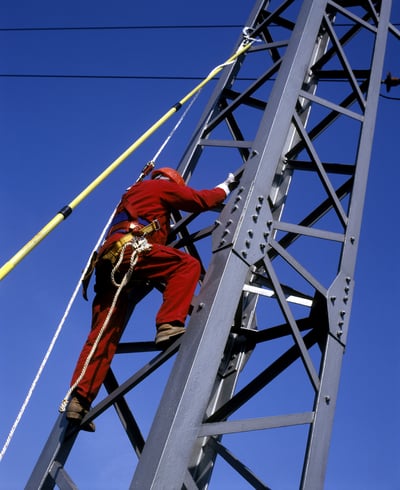Falls from a height continue to be the most common kind of fatal injury in the workplace for the 4th year running - with 171 fatal injuries from 2016-2021 being due to falls from a height. You may be wondering if you or your employees are classified as working at height and how the Work at Height Regulations (2005) apply to you.
In this blog, we run through exactly what working at height means and what this means for those who work in these environments in terms of ensuring the safety and wellbeing of employees.
The Working at Height Regulations (2005) were implemented to prevent death or injury to employees resulting from falls from a height. This legislation applies to employers of those who work from a height, as well as self-employed workers and those who manage people who conduct this sort of work. The Health and Safety Executive (HSE) define working at height as “work in any place where, if precautions were not taken, a person could fall a distance liable to cause personal injury”. We’ve put together a concise list of examples of working at a height below:
Working at height also includes work using ladders or on a flat roof. A common misconception of the Work at Height Regulations (2005) is that the use of ladders is to be avoided, which is false. Ladders, when used correctly and safely, can be a great practical option for completing work at a height - as long as individuals using the ladder are competent and the equipment is suitable.
Download your free copy of our ‘No-Nonsense Guide to the Working at Height Regulations (2005)’ to discover what this legislation means for you and what your next steps should be.
So, what does the term ‘working at height’ not include? Slips or trips at ground level are not classed as working at height, as a fall from height has to involve a fall from one level to a lower level.
As well as this, working at height does not include ascending or descending a permanent staircase in a building.

Employers, managers, and the self-employed must ensure that work conducted at a height is suitably planned, supervised, and carried out - those who do these things must be deemed competent.
The risks surrounding working at height will need to have been appropriately considered and managed via both collective and personal protection. Collective protection is a method of preventing and minimising the risk of a fall via equipment that doesn’t require any action from the worker - such as guard rails and can protect more than one person. It is not reliant on PPE. Personal protective equipment includes equipment to protect the individual like a harness, for example.
Don’t forget, the equipment in use also needs to be suitable and appropriate, meaning that proper maintenance and inspection should be conducted prior to use. Staying compliant with this legislation is important in order to protect your employees from harm, gain peace of mind that you are doing everything in your power to do this by educating yourself on what is required of you.
Get our expert knowledge delivered straight to your inbox, and keep up-to-date with the latest goings on in your industry.
Falls from a height continue to be the most common kind of fatal injury in the workplace for the 4th year running - with 171 fatal injuries from 2016-2021 being due to falls from a height. You may be ...
In 2005, the Work at Height Regulations (2005) were introduced to ensure the safety of those who work at potentially dangerous heights and they are still in place today. What does all this legal jargo...
According to HSE, you should be taking vital steps to protect your team when working at height. One way to minimise the likelihood of an accident is through the use of a Fall Arrest System.